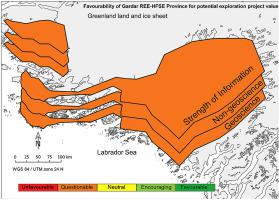Geoscience Frontiers ( IF 8.5 ) Pub Date : 2020-07-18 , DOI: 10.1016/j.gsf.2020.05.019 Graham J. Banks , Símun D. Olsen , Antonio Gusak

|
The rare earth elements and high-field-strength elements (REE-HFSE) exploration sector conducts most evaluations at deposit and smaller scales. It is not evident how the sector performs a preceding exploration stage—rating and prioritising REE-HFSE mineralised provinces—to determine which provinces are prospective enough to warrant investment. Here we present an objective, repeatable, low-cost method to screen any REE-HFSE province, as a foundation for district-scale investigations or asset evaluations. It is original for REE-HFSE screening, and adapted from regional scale copper, cobalt and petroleum exploration, and CO2 storage, screening methods. It is centred upon a mineralised province’s favourability for potential value creation, and to identify: (a) its main information gaps; (b) its weakest links; (c) its exploration maturity and remaining potential category; (d) how it compares against other REE-HFSE provinces; and (e) if further investigation is justified. This method incorporates geoscience, strategy, economic and socio-environmental factors in a way that is understandable and directly usable across stakeholder groups. The workflow is systematic, yet flexible enough to accommodate organisation-specific criteria, and usable for other commodities. It provides the platform to build a global REE-HFSE province map and database consistently across national boundaries and organisations. Categories for the extent of province exploration maturity and remaining mineral potential are proposed. We illustrate the applicability of these methods using the Gardar REE-HFSE Province (GRHP) of south Greenland. We conclude that it is a moderate size, frontier province that is currently of questionable favourability for value creation. To move GRHP into a positive favourability class, its current weak links need strengthening by research, government policy and industry stakeholders: evaluate the mineral system; integrate all information geospatially and place it in the public domain; help the region improve some community health and safety issues; convert some mineral resources into an Ore Reserves category; commence mining and sales production.
中文翻译:

一种通过价值创造潜力评估REE-HFSE矿产省的方法和应用示例:格陵兰Gardar REE-HFSE省
稀土元素和高场强元素(REE-HFSE)勘探部门在矿床和较小规模下进行大多数评估。目前尚不清楚该部门如何进行之前的勘探阶段(对REE-HFSE矿化省进行评级和优先级确定),以确定哪些省有足够的潜力来保证投资。在这里,我们提出了一种客观,可重复,低成本的方法来筛选任何REE-HFSE省,以此作为地区规模调查或资产评估的基础。它是最初用于REE-HFSE筛选的,并改编自区域规模的铜,钴和石油勘探以及CO 2储存,筛选方法。它着眼于一个矿化省对潜在价值创造的有利程度,并确定:(a)主要信息空白;(b)最薄弱的环节;(c)勘探成熟度和剩余潜力类别;(d)与其他REE-HFSE省份相比如何?(e)是否有理由进行进一步调查。这种方法以一种在利益相关者群体之间可以理解和直接使用的方式结合了地球科学,战略,经济和社会环境因素。工作流是系统的,但足够灵活以适应组织特定的标准,并且可用于其他商品。它提供了一个平台,可跨国家边界和组织一致地构建全球REE-HFSE省地图和数据库。提出了省级勘探成熟度和剩余矿产潜力的类别。我们使用南格陵兰的Gardar REE-HFSE省(GRHP)说明了这些方法的适用性。我们得出的结论是,这是一个中等规模的边境省份,目前对创造价值的有利程度令人怀疑。为了使GRHP进入积极的优惠级别,其当前的薄弱环节需要通过研究,政府政策和行业利益相关者的加强:评估矿产系统;地理上整合所有信息并将其置于公共领域;帮助该地区改善一些社区健康和安全问题;将一些矿产资源转换为矿石储量类别;开始采矿和销售生产。我们使用南格陵兰的Gardar REE-HFSE省(GRHP)说明了这些方法的适用性。我们得出的结论是,这是一个中等规模的边境省份,目前对创造价值的有利程度令人怀疑。为了使GRHP进入积极的优惠级别,其当前的薄弱环节需要通过研究,政府政策和行业利益相关者的加强:评估矿产系统;地理上整合所有信息并将其置于公共领域;帮助该地区改善一些社区健康和安全问题;将一些矿产资源转换为矿石储量类别;开始采矿和销售生产。我们使用南格陵兰的Gardar REE-HFSE省(GRHP)说明了这些方法的适用性。我们得出的结论是,这是一个中等规模的边境省份,目前对创造价值的有利程度令人怀疑。为了使GRHP进入积极的优惠级别,其当前的薄弱环节需要通过研究,政府政策和行业利益相关者的加强:评估矿产系统;地理上整合所有信息并将其置于公共领域;帮助该地区改善一些社区健康和安全问题;将一些矿产资源转换为矿石储量类别;开始采矿和销售生产。为了使GRHP进入积极的优惠级别,其当前的薄弱环节需要通过研究,政府政策和行业利益相关者的加强:评估矿产系统;地理上整合所有信息并将其置于公共领域;帮助该地区改善一些社区健康和安全问题;将一些矿产资源转换为矿石储量类别;开始采矿和销售生产。为了使GRHP进入积极的优惠级别,其当前的薄弱环节需要通过研究,政府政策和行业利益相关者的加强:评估矿产系统;地理上整合所有信息并将其置于公共领域;帮助该地区改善一些社区健康和安全问题;将一些矿产资源转换为矿石储量类别;开始采矿和销售生产。











































 京公网安备 11010802027423号
京公网安备 11010802027423号